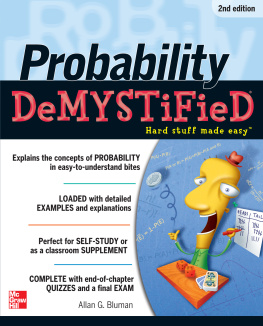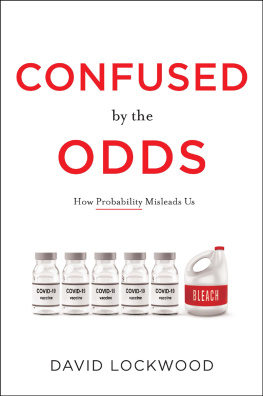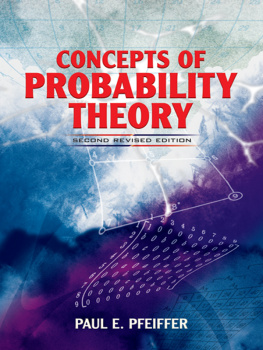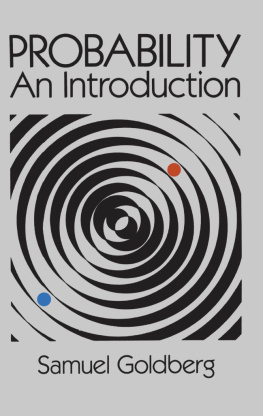Acknowledgments
I would like to thank my wife, Betty Claire, for helping me with the preparation of this book and my editor, Judy Bass, for her assistance in its publication. I would also like to thank Eugene Mastroianni for his error checking and helpful suggestions.
Answers to Quizzes and Final Exam
. C
. C
. A
. D
. B
. D
. C
. D
. D
. D
. D
. B
. A
. B
. C
. C
. B
. D
. A
. C
. D
. C
. A
. D
. A
. B
. C
. A
. A
. B
. C
. B
. D
. C
. B
. B
. B
. B
. A
. B
. C
. B
. D
. A
. D
. D
. A
. C
. B
. C
. A
. C
. D
. B
. B
. A
. A
. A
. C
. B
. B
. B
. A
. B
. C
. C
. B
. D
. A
. C
. D
. A
. C
. C
. C
. D
. B
. C
. D
. D
. C
. B
. C
. A
. D
. D
. C
. A
. C
. D
. C
. D
. A
. A
. C
. C
. A
. B
. B
. B
. D
. C
. C
. B
. D
. B
. C
. A
. A
. C
. B
. B
. A
. C
. B
. A
. D
. C
. D
. A
. C
. D
. A
. B
. B
. D
. C
. D
. D
. D
. A
. B
. C
. D
. D
. B
. C
. B
. D
. D
. D
. D
. C
. B
. B
. A
. C
. D
. A
. B
. D
. A
. C
. C
. C
. B
. A
. B
. A
. D
. B
. B
. C
. A
. D
. C
. B
. D
. B
. A
. B
. D
. C
. B
. C
. D
. A
. D
. A
. C
. B
. B
. D
. C
. A
. A
. D
. A
. C
. B
. B
. B
. A
. A
. A
. D
. A
. C
. A
. A
. B
. B
. C
. B
. D
. D
. B
. A
. D
. C
appendix
Bayes Theorem
A somewhat more difficult topic in probability is called Bayes theorem.
Given two dependent events, A and B, the previous formulas allowed you to find P( A and B) or P( B | A). Related to these formulas is a principle developed by an English Presbyterian minister, Thomas Bayes (17021761). It is called Bayes theorem.
Knowing the outcome of a particular situation, Bayes theorem enables you to find the probability that the outcome occurred as a result of a particular previous event. For example, suppose you have two boxes containing red balls and blue balls. Now if it is known that you selected a blue ball, you can find the probability that it came from Box 1 or Box 2. A simplified version of Bayes theorem is given next.
For 2 mutually exclusive events, A and B, where event B follows event A,
EXAMPLE
__________________________________
Box 1 contains two red balls and one blue ball. Box 2 contains one red ball and three blue balls. A coin is tossed; if it is heads, Box 1 is chosen, and a ball is selected at random. If the toss yields tails, Box 2 is chosen. If the ball is red, find the probability it came from Box 1.
SOLUTION
_________________________
Let A = selecting Box 1 and = selecting Box 2. Since the selection of a box is based on a coin toss, the probability of selecting Box 1 is and the probability of selecting Box 2 is ; hence, P( A) and P( ) . Let B = selecting a red ball and = selecting a blue ball. From Box 1, the probability of selecting a red ball is , and the probability of selecting a blue ball is since there are two red balls and one blue ball. Hence, P( B| A) and P( | A) . Since there is one red ball in Box 2, P( B| ) is , and since there are 3 blue balls in Box 2, P( | ) . The probabilities are shown in .
FIGURE A-1
Hence,
In summary, if a red ball is selected, the probability that it came from Box 1 is .
EXAMPLE
__________________________________
Two video products distributors supply video tape boxes to a video production company. Company A sold 100 boxes of which five were defective. Company B sold 300 boxes of which 21 were defective. If a box was defective, find the probability that it came from Company B.
SOLUTION
_________________________
Let D = the event that the box is defective and = the event that the box is not defective.
Let P( A) = probability that a box selected at random is from Company A; also, let B = . Then P( A) ; P( B) = P( ) . Since there are 5 defective boxes from Company A, P( D| A) and there are 21 defective types from Company B or , P( D| ) . The probabilities are shown in .
FIGURE A-2
PRACTICE
__________________________________
1. Box 1 contains six green marbles and four yellow marbles. Box 2 contains five yellow marbles and five green marbles. A box is selected at random and a marble is selected from the box. If the marble is green, find the probability that it came from Box 1.








